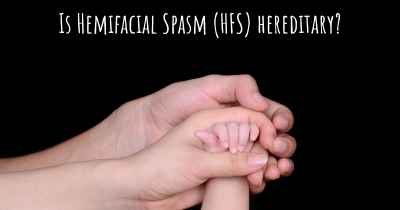What is the life expectancy of someone with Hemifacial Spasm (HFS)?
Life expectancy of people with Hemifacial Spasm (HFS) and recent progresses and researches in Hemifacial Spasm (HFS)

Hemifacial spasm (HFS) is a neurological condition characterized by involuntary muscle contractions on one side of the face. While HFS can significantly impact a person's quality of life, it does not directly affect life expectancy. The condition is typically not life-threatening, and individuals with HFS can live a normal lifespan. However, it is important to note that the severity and progression of HFS can vary among individuals. Seeking medical advice and appropriate treatment options, such as medications or surgery, can help manage symptoms and improve the overall well-being of individuals with HFS.
Hemifacial spasm (HFS) is a neurological disorder characterized by involuntary contractions or twitching of the muscles on one side of the face. This condition typically begins with mild spasms around the eye or mouth and gradually progresses over time. While HFS can significantly impact a person's quality of life, it is important to note that it is not a life-threatening condition.
The exact life expectancy of someone with HFS cannot be determined as it varies from person to person. The prognosis depends on several factors, including the underlying cause of the condition, the severity of symptoms, and the individual's overall health. However, it is crucial to understand that HFS itself does not directly affect life expectancy.
HFS is most commonly caused by compression or irritation of the facial nerve on the affected side of the face. This compression can be due to various factors, such as a blood vessel pressing against the nerve or a facial nerve injury. In some cases, the cause of HFS may be unknown, referred to as idiopathic HFS.
The symptoms of HFS can range from mild to severe, and they typically worsen over time. Initially, individuals may experience occasional twitching or spasms, which can progress to frequent and prolonged contractions. These spasms can be triggered by various factors, including stress, fatigue, or certain facial movements.
While HFS itself is not life-threatening, it can significantly impact a person's quality of life. The constant twitching and muscle contractions can cause embarrassment, social anxiety, and difficulty with daily activities such as eating, speaking, or even driving. The psychological and emotional toll of living with HFS should not be underestimated.
Fortunately, there are treatment options available to manage the symptoms of HFS. The most common approach is the use of medications such as anticonvulsants or muscle relaxants to reduce muscle spasms. In some cases, botulinum toxin injections may be recommended to temporarily paralyze the affected muscles and provide relief.
In more severe cases or when conservative treatments fail to provide adequate relief, surgical interventions may be considered. Microvascular decompression surgery aims to relieve the compression on the facial nerve by repositioning or removing the blood vessel causing the irritation. Other surgical options include selective denervation, where the nerves responsible for the spasms are cut, or neurectomy, which involves removing a portion of the facial nerve.
It is important for individuals with HFS to work closely with healthcare professionals to develop a personalized treatment plan. Regular follow-ups and adjustments to the treatment approach may be necessary to manage symptoms effectively and improve quality of life.
In conclusion, the life expectancy of someone with Hemifacial Spasm (HFS) is not directly affected by the condition itself. HFS is a chronic neurological disorder that can significantly impact a person's quality of life due to the constant facial muscle contractions. However, with appropriate treatment and management, individuals with HFS can lead fulfilling lives and effectively cope with the challenges posed by the condition.
Posted Mar 8, 2017 by Ladrita 1150








